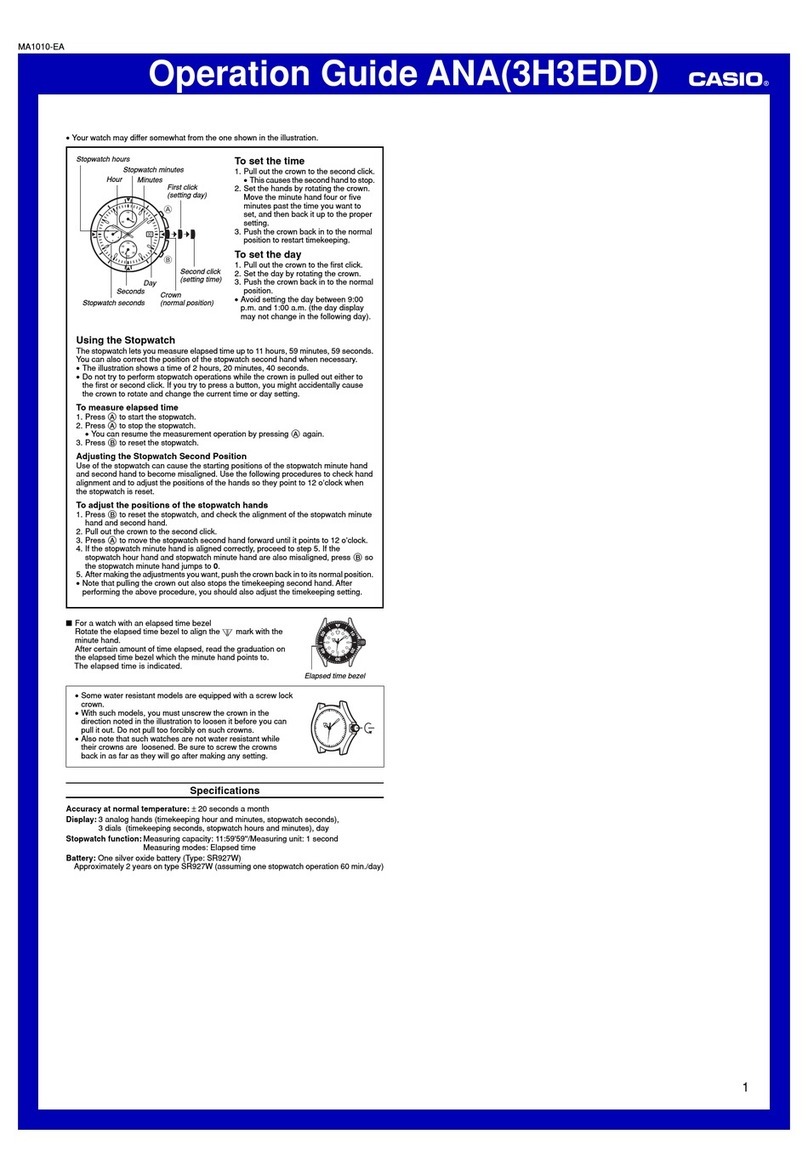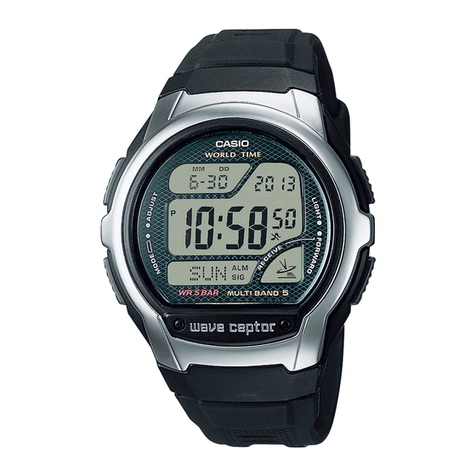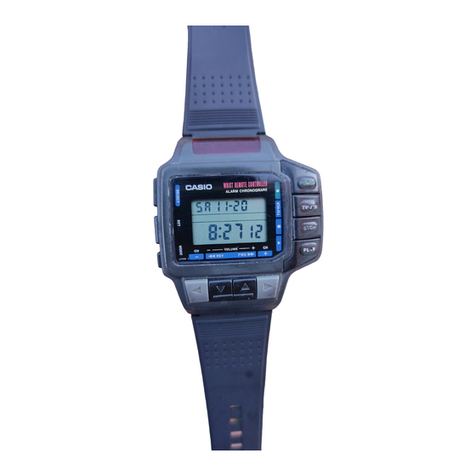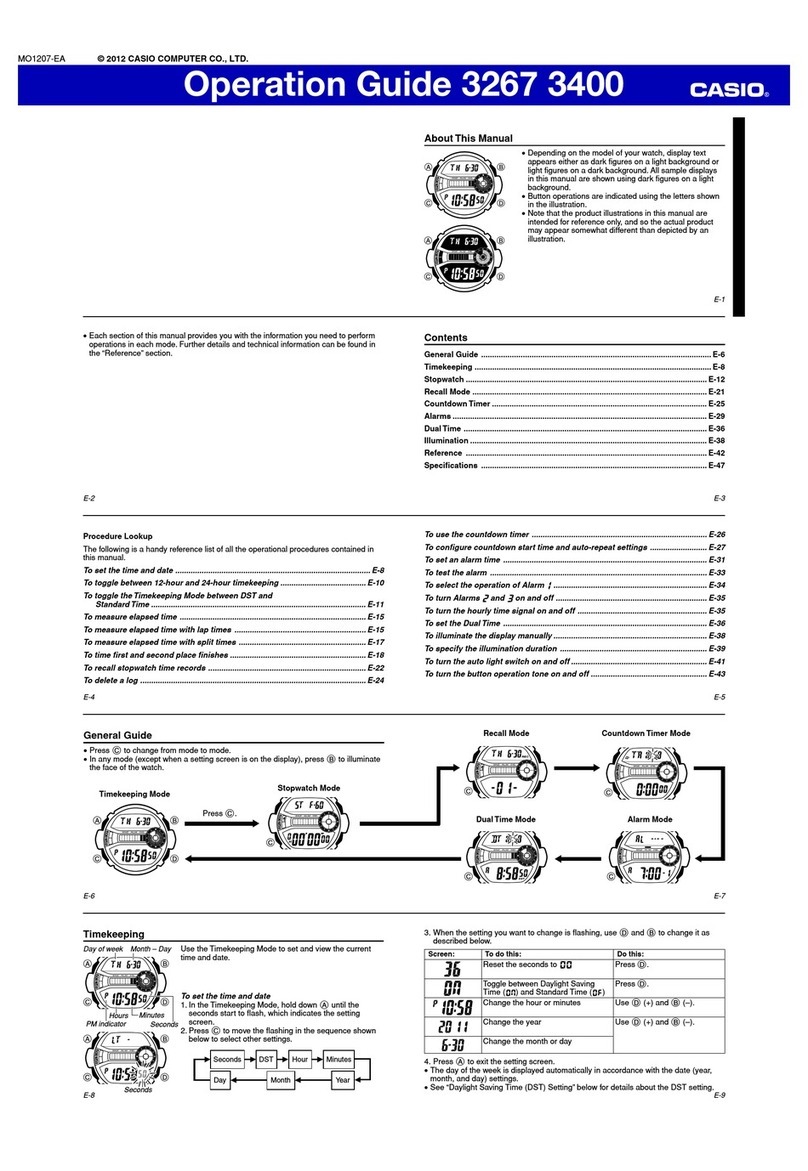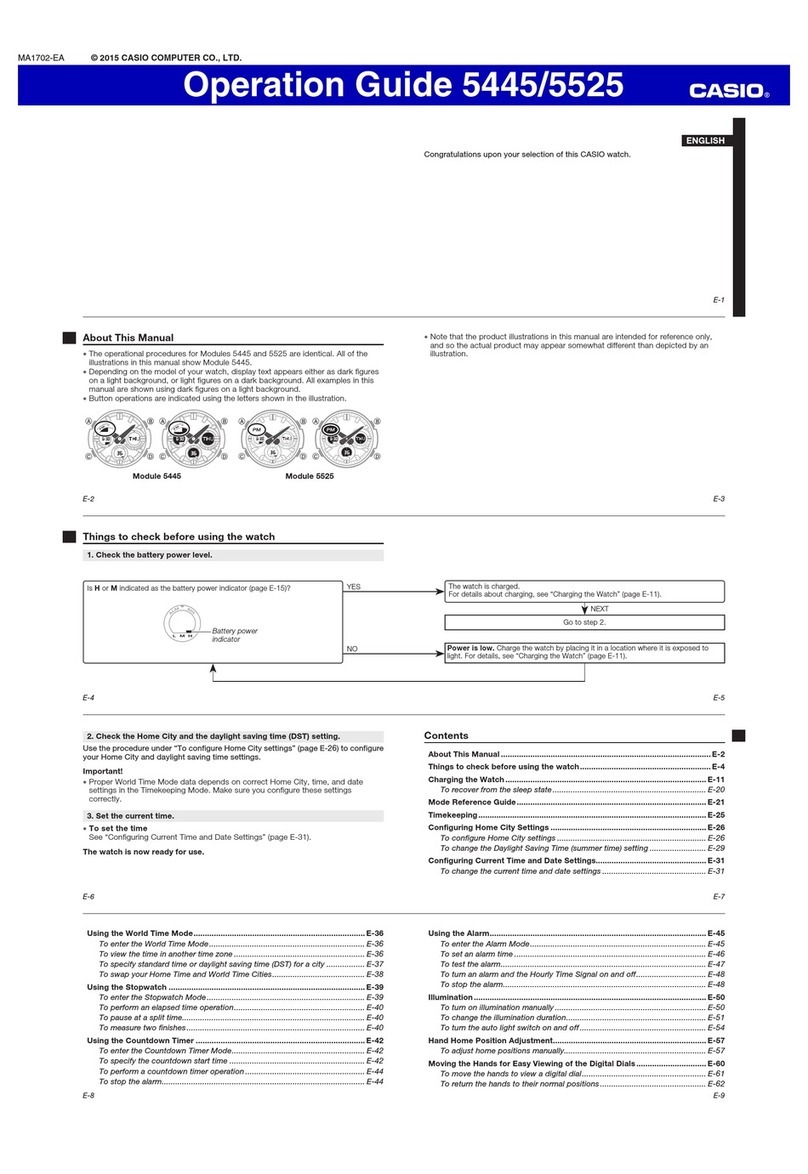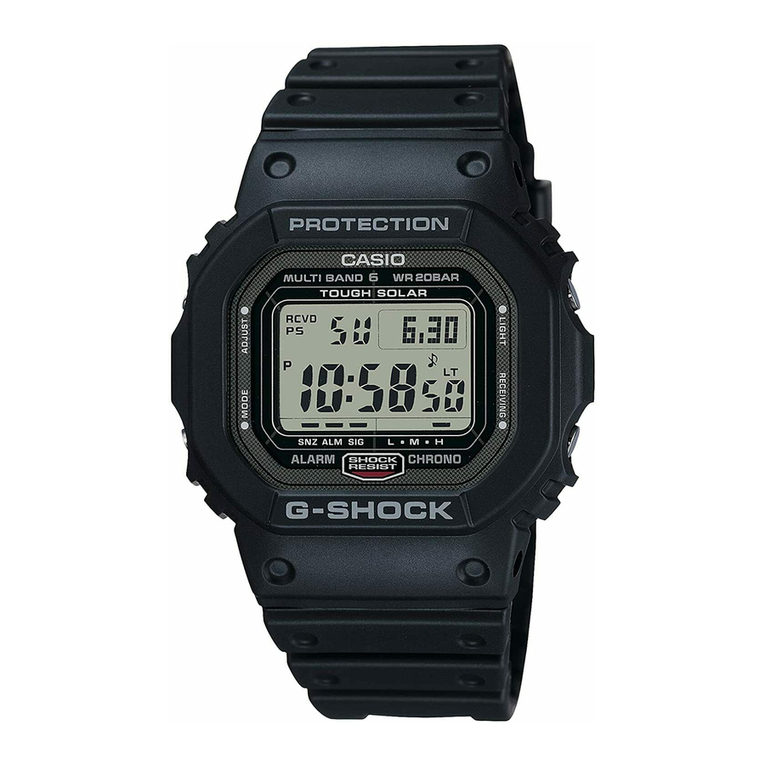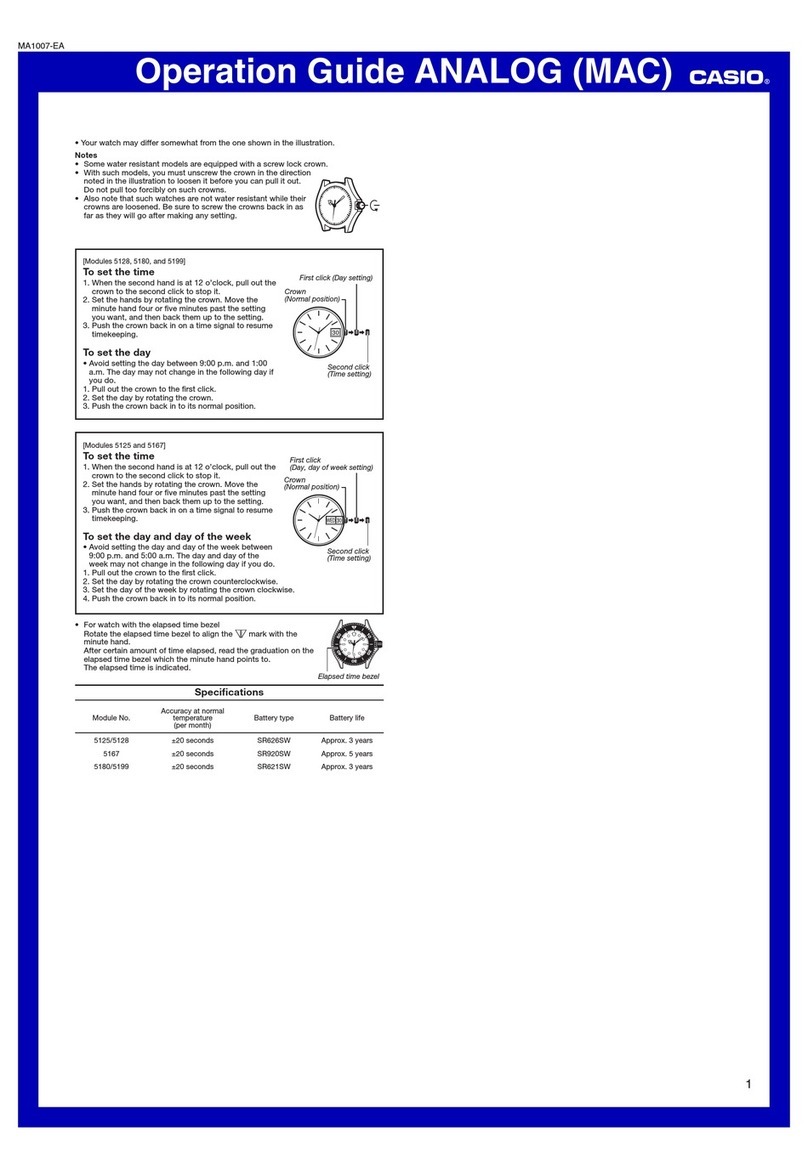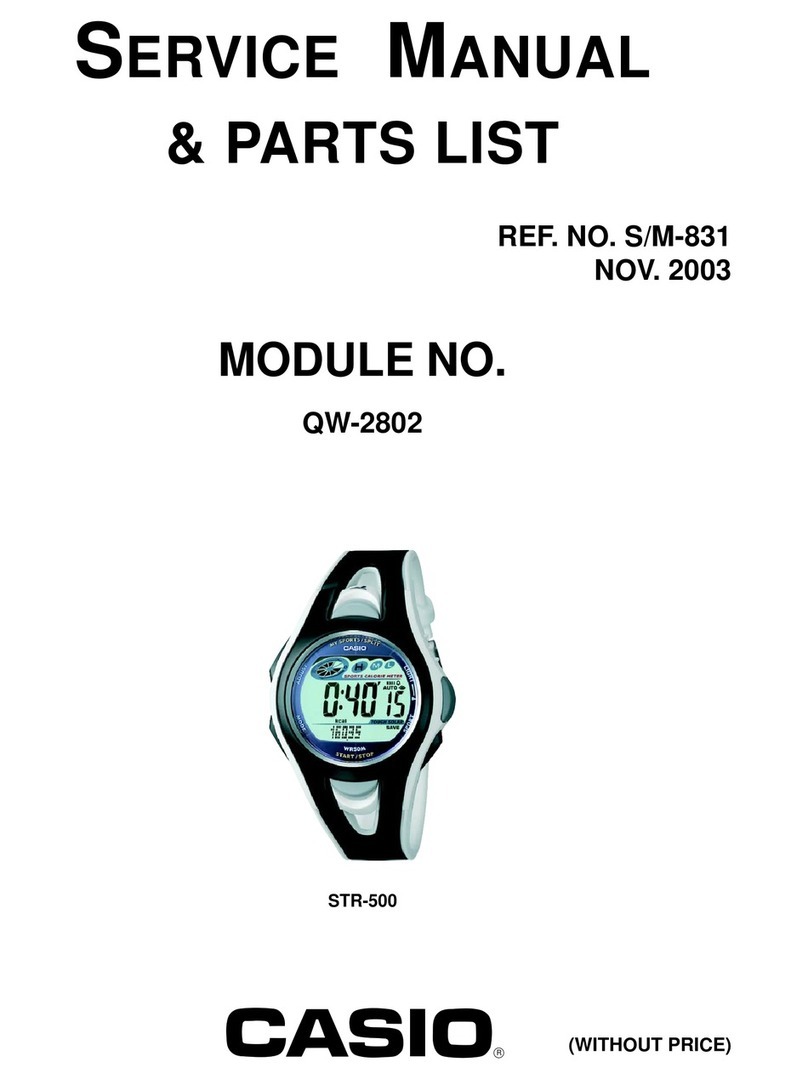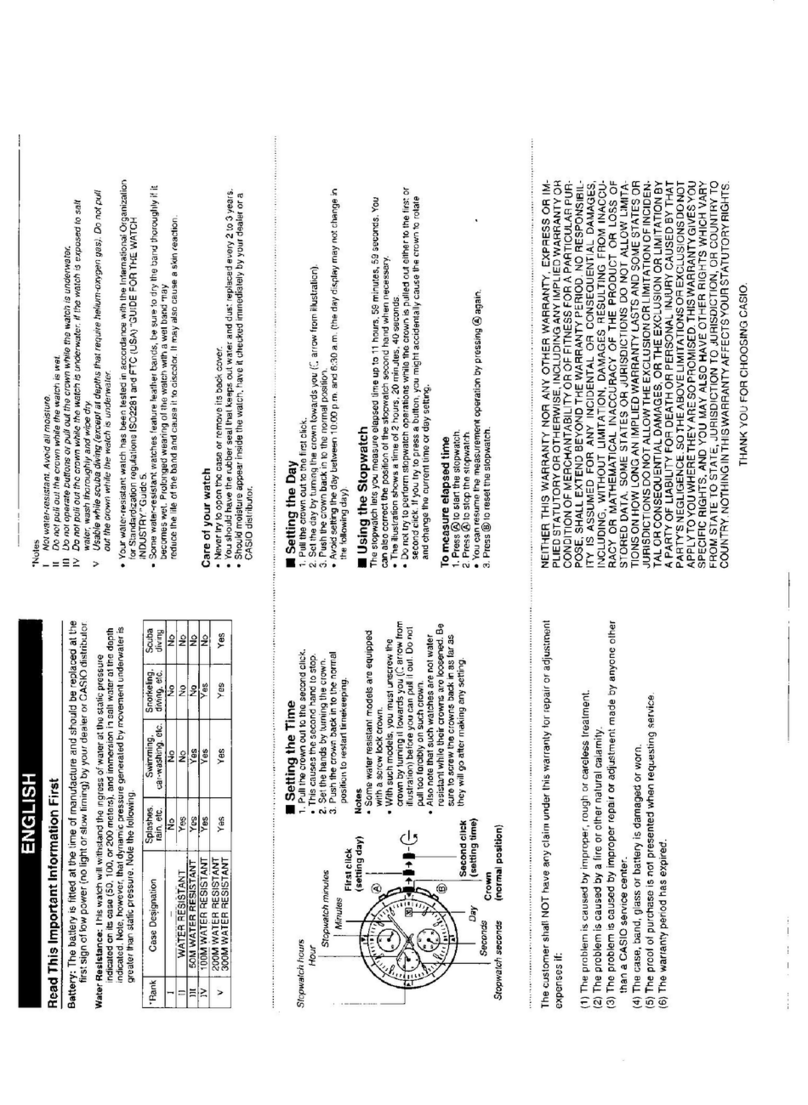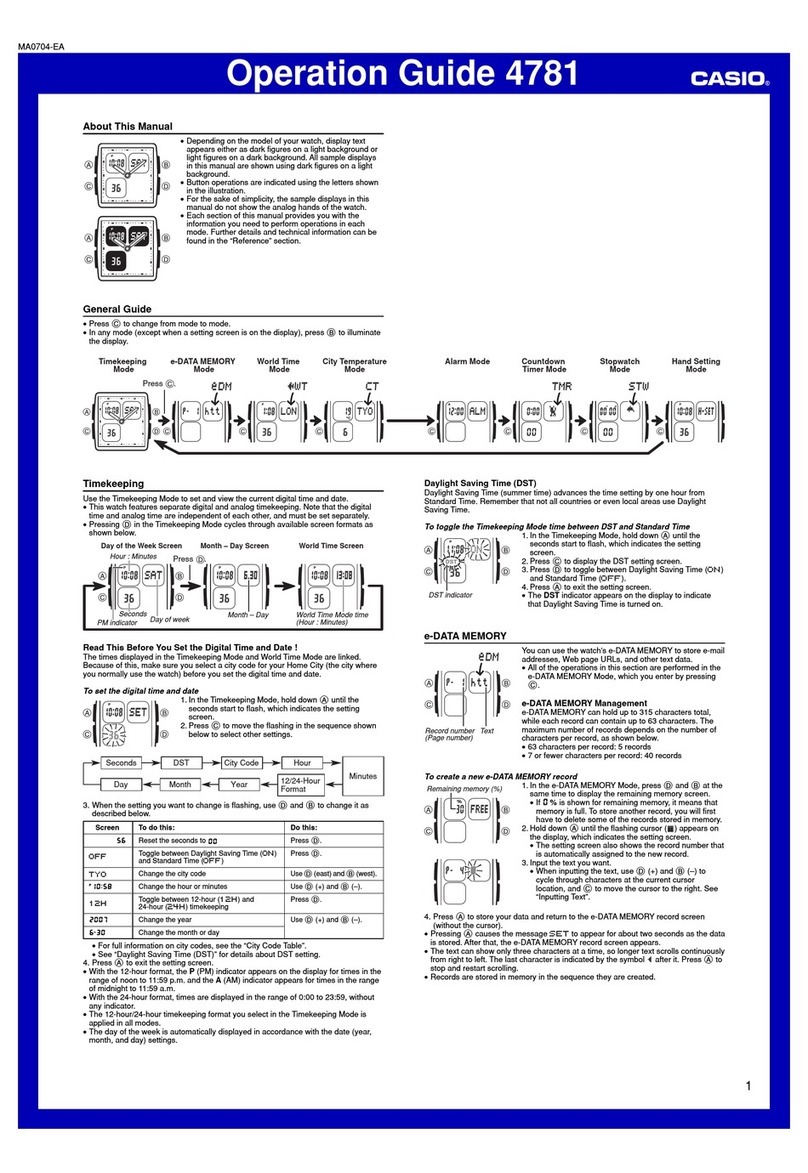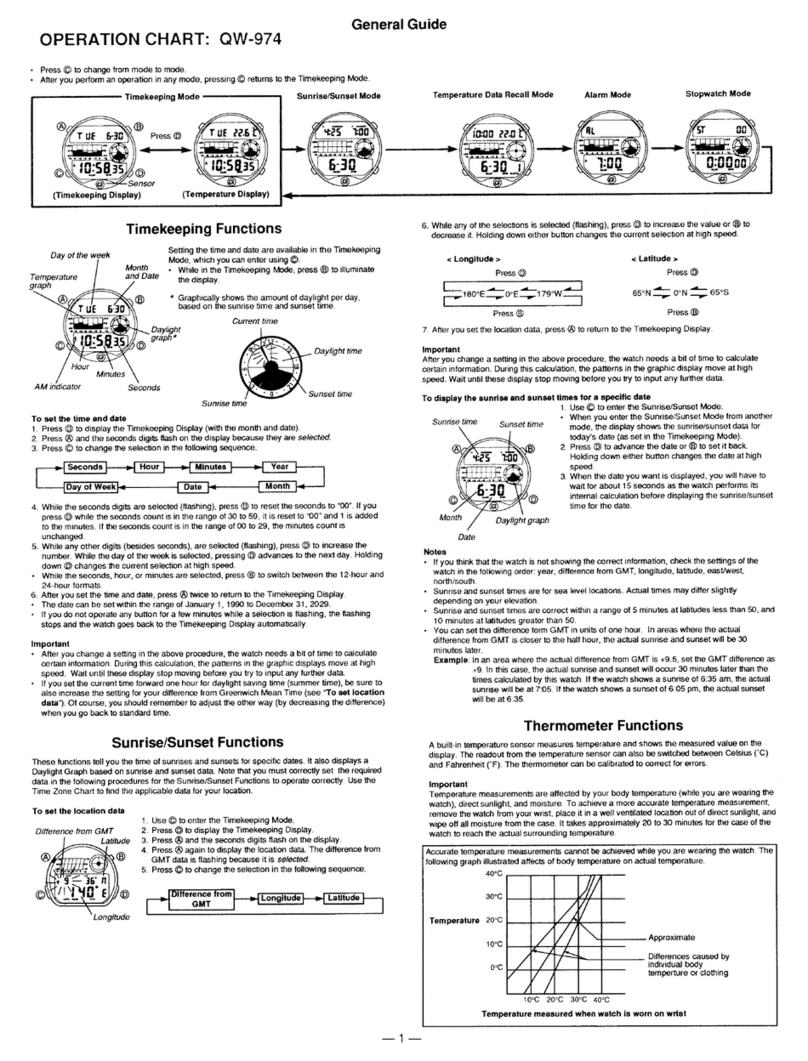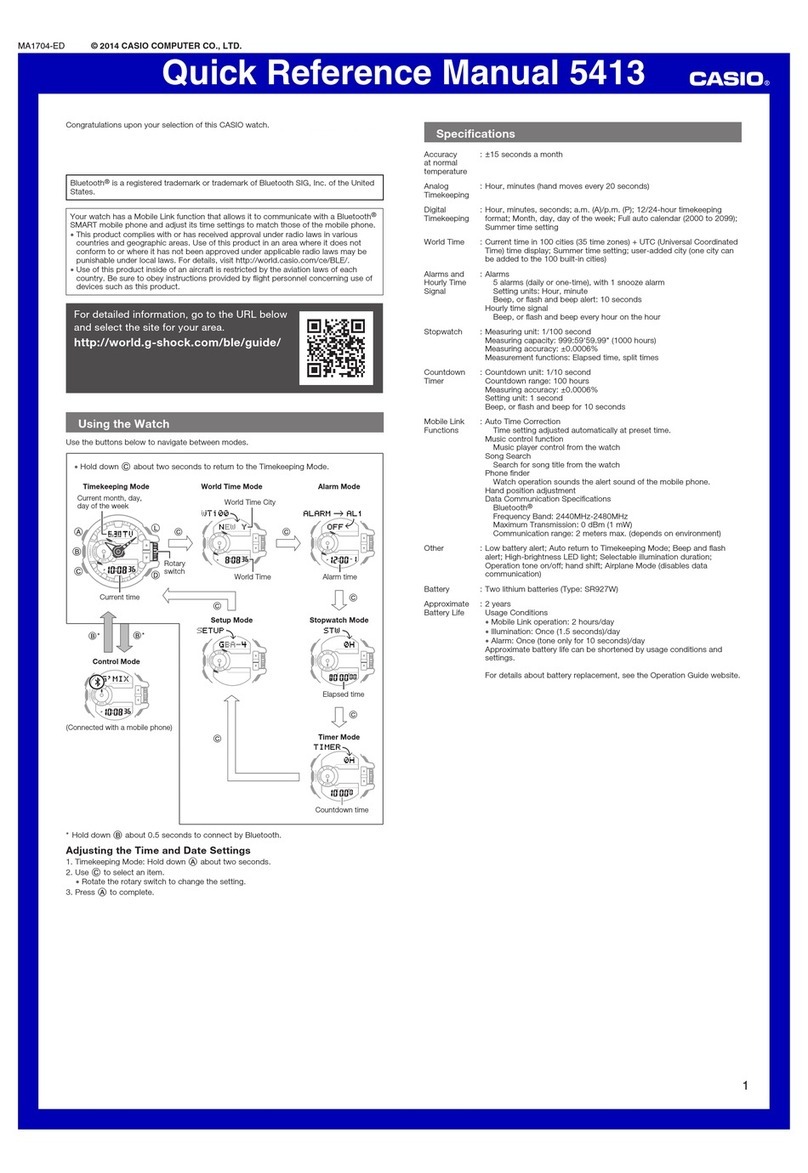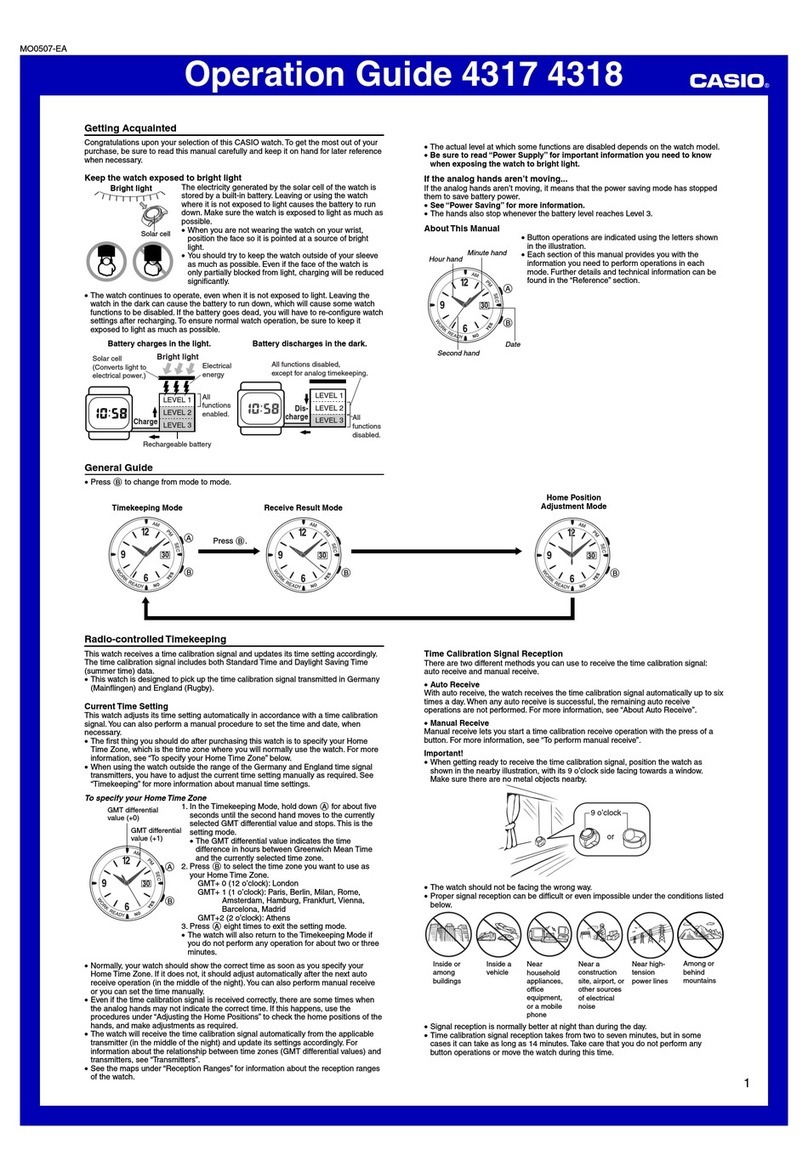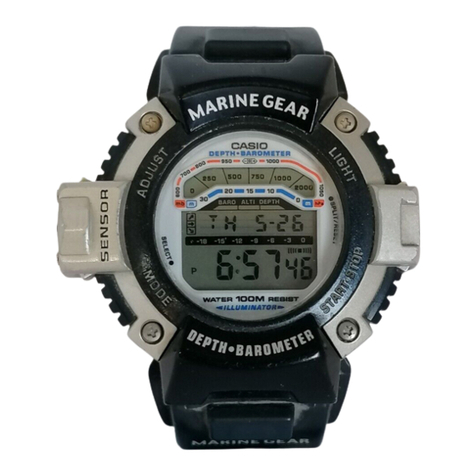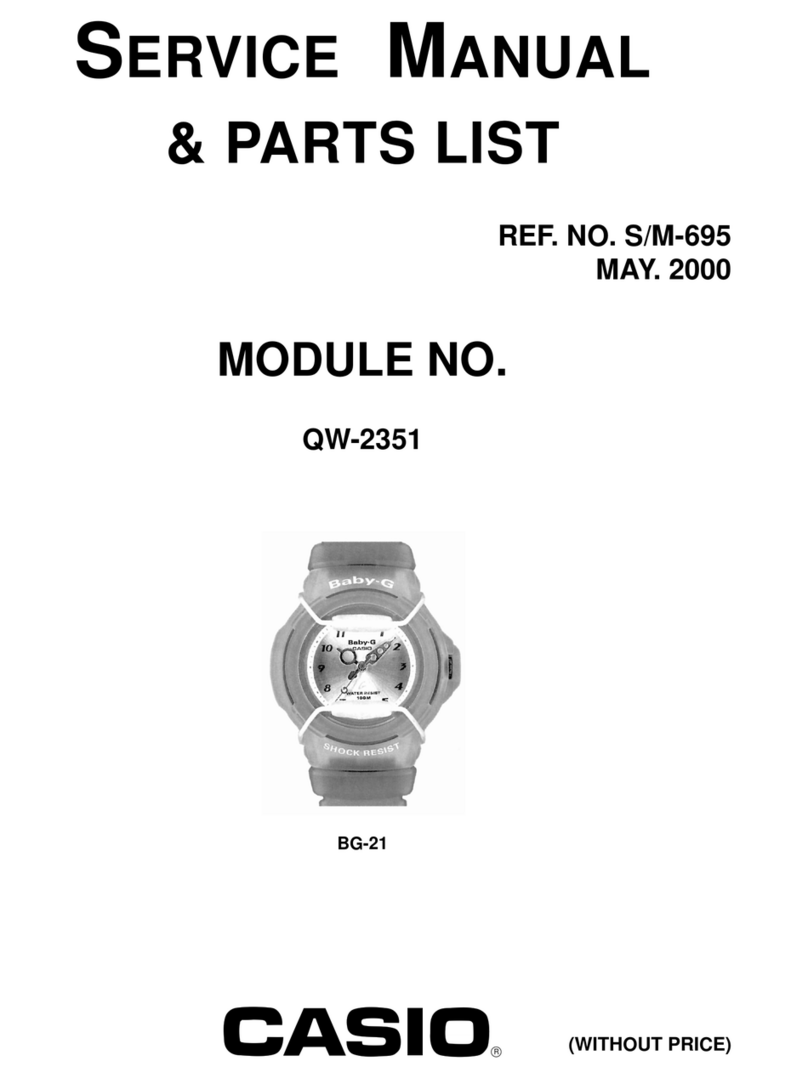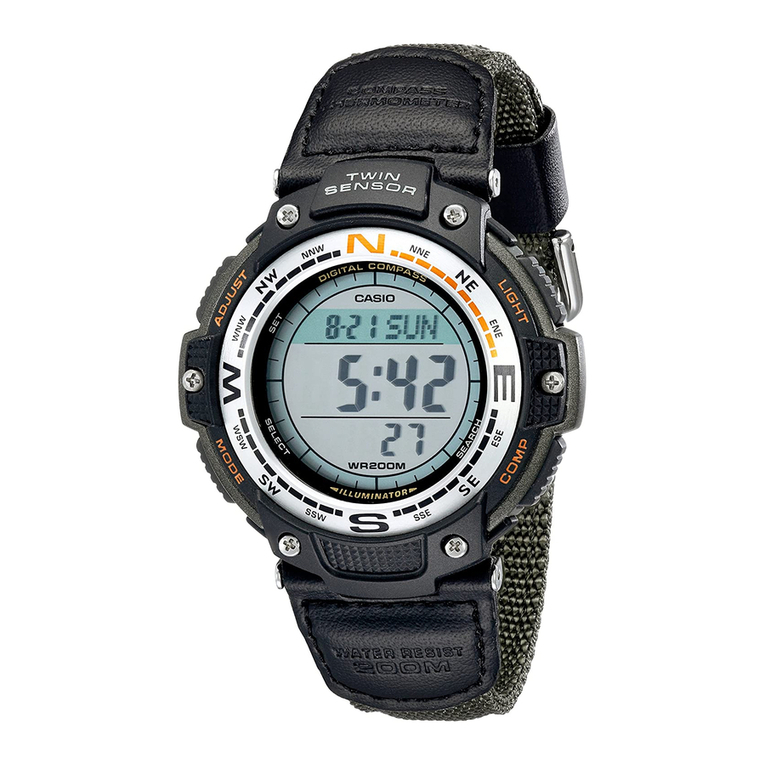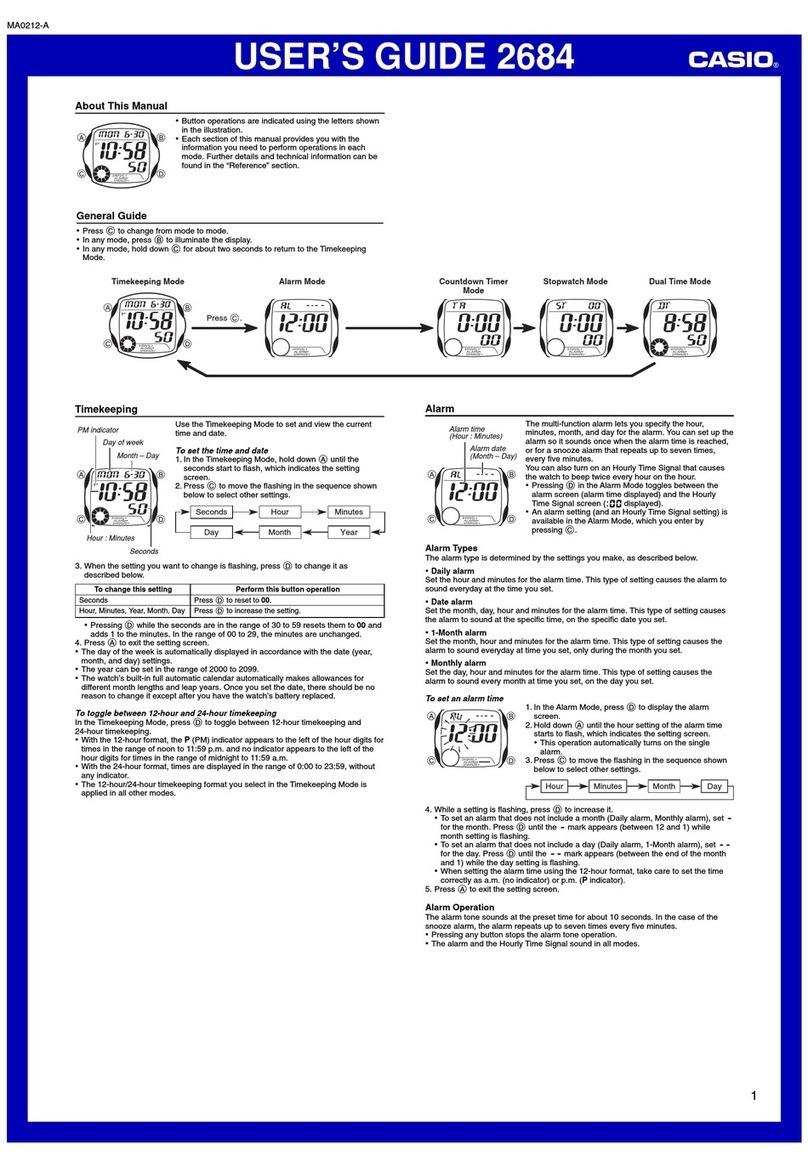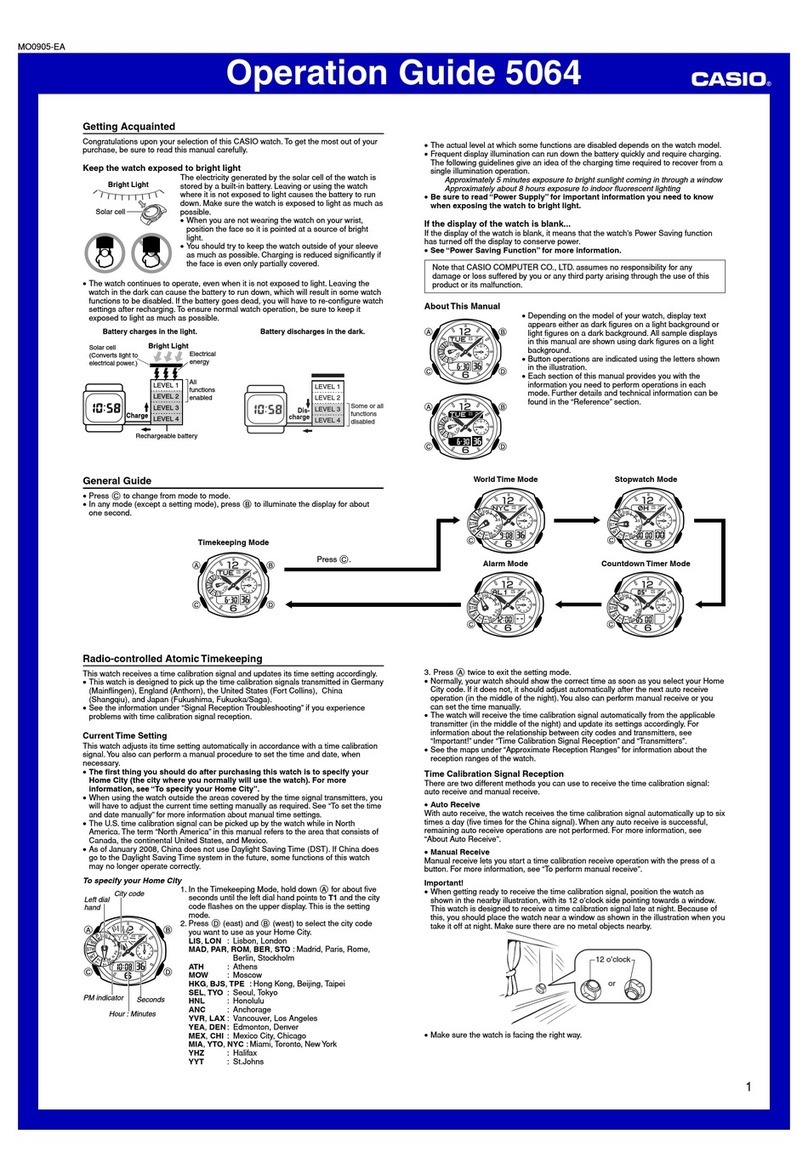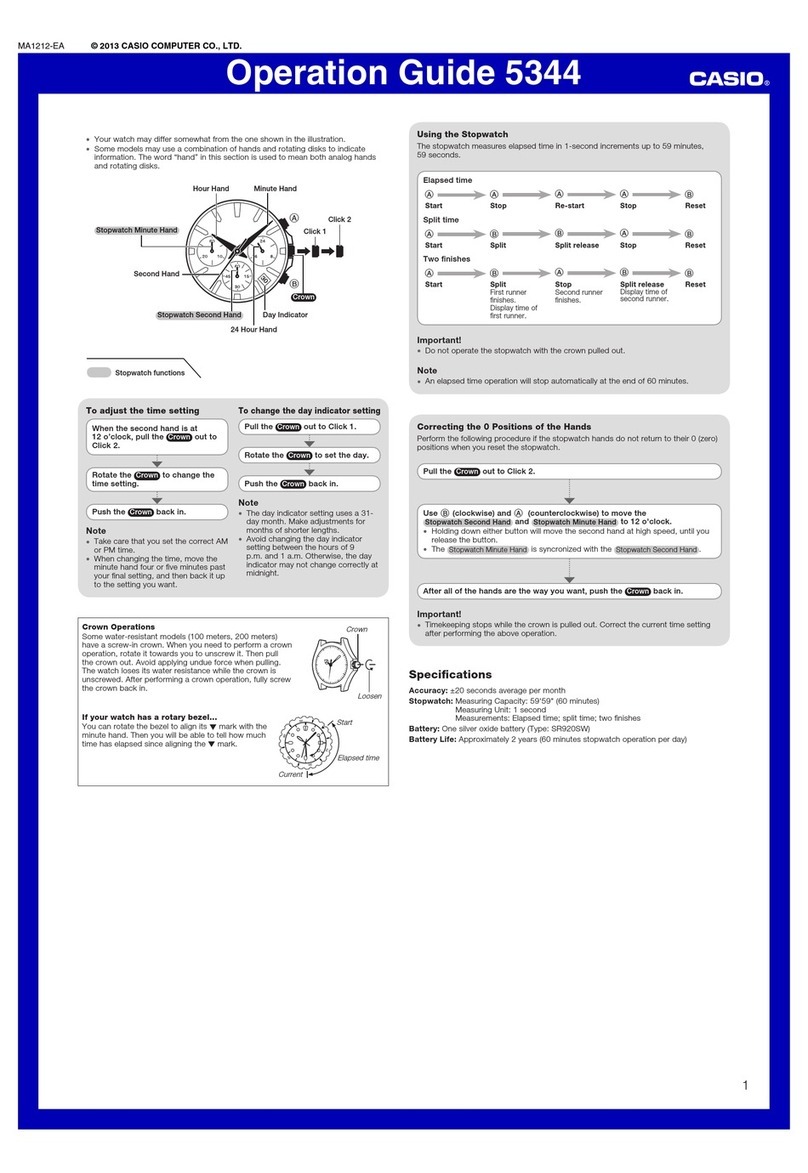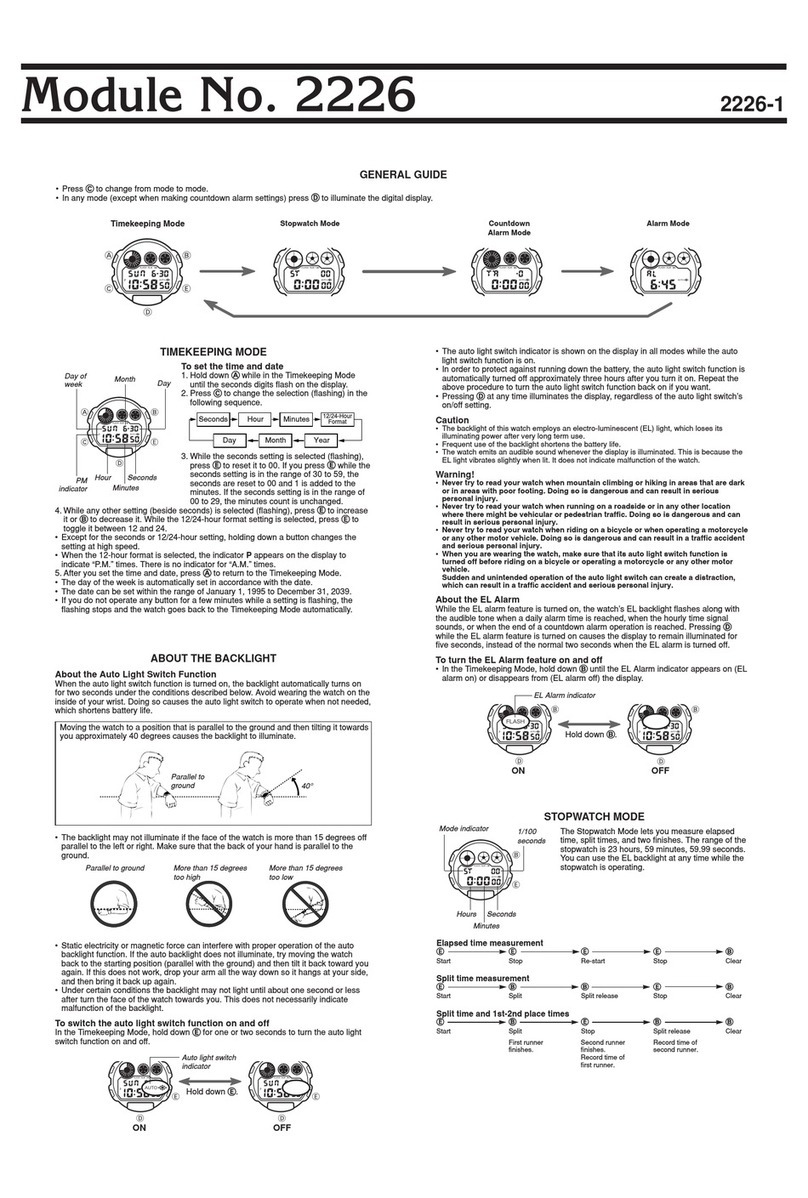
—3 —
To perform manual time calibration signal reception
1.Place the watch on a stable surface to its top (12
o’clock side) is facing in the general direction of
Frankfurt, Germany.
•This puts the watch in the optimum position for time
calibration signal reception.
2.In the Timekeeping Mode, hold down Dfor about two
seconds, until the watch beeps.
•At this time, the indicator on the watch’s display
should scroll from left to right, which indicates that
signal reception has started.
•Time calibration signal reception takes from four to 11
minutes. Take care that you do not move the watch
during this time.
•After signal reception is complete, the display of the
watch changes to the Last Signal screen, which
shows the new signal receive date and time.
Note
•To interrupt a receive operation and return to the Timekeeping screen, press D.
•If the receive operation is unsuccessful, the message “ERR”appears on the Last
Signal screen for about one or two minutes. After that, the watch returns to the
Timekeeping screen.
•You can also change from the Last Signal screen to the Timekeeping screen by
pressing D.
About the Receive Indicator
The receive indicator shows the strength of the calibration signal being received. For
best reception, be sure to keep the watch in a location where signal strength is
strongest.
•Even in an area where signal strength is strong, it takes about 10 seconds for signal
reception to stabilize enough for the receive indicator to indicate signal strength.
•Use the receive indicator as a guide for checking signal strength and for finding the
best location for the watch during signal receive operations.
•The receive indicator remains on the display in all modes following reception of the
time calibration signal and calibration of the watch’s time setting. The receive
indicator does not appear if signal reception was unsuccessful or after manual
adjustment of the current time setting.
About Auto Receive
When auto receive is turned on, the watch automatically starts to receive the time
calibration signal when the digital time in the Timekeeping Mode reaches 2:00AM,
4:00 AM, and 6:00AM each day (calibration times).
Note
•TheAuto Receive operation is performed only if the watch is in the Timekeeping
Mode or World Time Mode when one of the calibration times is reached. It is not
performed if the calibration time is reached while you are making settings (while
settings are flashing on the display).
•Auto receipt of the calibration signal is designed to be performed early in the
morning, while you sleep (provided that the digital time is set correctly). Before going
to bed for the night, remove the watch from your wrist, and put it in a location where
it can easily receive the signal.
•The receive indicator ( ) indicates that one, two, or all three of the last calibration
time reception attempts were successful.
•When auto receive is turned on, the watch receives the calibration signal for four to
11 minutes each day when the digital time reaches 2:00 AM, 4:00AM, and 6:00 AM.
Do not operate any of the watch’s buttons within 15 minutes prior to or following the
calibration times. Doing so can interfere with correct calibration.
•Remember that reception of the calibration signal depends on the time shown on the
digital display. The receive operation will be performed whenever the digital display
shows 2:00 AM, 4:00AM, and 6:00 AM, regardless of whether or not the displayed
time is actually the correct time.
•When two or three receptions are successful, the watch uses the data of the last
reception for calibration. When only one reception is successful, the watch uses the
data of the successful reception.
Weak Strong
Current time
Receive indicator
To turn auto receive on and off
1.In the Timekeeping Mode, hold down Auntil the
current Auto Receive On/Off setting starts to flash,
which indicates the setting screen.
2.Press Dto toggle Auto Receive on (ON) and off (OFF).
3.Press Ato exit the setting screen.
ALARMS
You can set three independent DailyAlarms, and even
input text that appears on the display to remind you of the
purpose of each alarm. When an alarm is turned on, the
alarm tone sounds when the alarm time is reached.You
can also turn on an Hourly Time Signal that causes the
watch to beep twice every hour on the hour.
•The remaining time shows the amount of time from the
current time (Timekeeping Mode time) until the alarm
time whose screen is on the display.
•The alarm number (“AL1”though “AL3”) indicates an
alarm screen. “SIG”appears in place of the alarm
number when the Hourly Time Signal screen is shown.
•All of the operations in this section are performed in the
Alarm Mode, which you enter by pressing C.
Alarm number
Alarm time
Text
Remaining time (Hours :
Minutes Seconds)
To set an alarm
1.In the Alarm Mode, useBand Dto select the alarm
whose time you want to set.
2.Hold down Auntil the flashing cursor appears on the
display, which indicates the setting screen.
•This automatically turns on the alarm.
•Holding down Lfor about two seconds at this time
sets an alarm time of 12:00AM, without assigning any
text to the alarm.
3.Press Cto move the flashing in the sequence shown
below to select other settings.
HourText Minutes
•There are eight spaces in the text, so you have to press Ceight times to move to
the Hour setting.
Cursor
To view Alarm Mode screen
In the Alarm Mode, use Band Dto cycle through the alarm screens as shown
below.
•Displaying an alarm time shows any text assigned to it for about two seconds (or a
blank screen if no text is assigned), followed by the remaining time screen.
•Your watch comes preset with the text data “LUNCH”and an alarm time of 12:00PM
(noon) for alarm AL1. You can use this setting as it is or change it to something else.
Press D.
Press B.
AL1 AL2 AL3 SIG
To test the alarm
In the Alarm Mode, hold down Dto sound the alarm.
To turn an alarm and the Hourly Time Signal on and off
1. In the Alarm Mode, use Band Dto select an alarm or the Hourly Time Signal.
2. When the alarm or the Hourly Time Signal you want to is selected, press Ato turn
it on and off.
Note
•The on/off status of an alarm is indicated on the corresponding alarm screen (AL1
through AL3). The symbol indicates an alarm is turned on, while absence of the
symbol indicates the alarm is turned off.
•The on/off status of the Hourly Time Signal is indicated on the SIG screen. The
symbol along with the message “ON”indicates the Hourly Time Signal is turned
on, while the message “OFF”without the symbol indicates it is turned off.
•The alarm on indicator and the Hourly Time Signal on indicator are shown on the
display in all modes while these functions are turned on.
•If any alarm is on, the alarm on indicator is shown on the display in all modes.
4. When the setting you want to change is selected, use Band Dto change it.
•Selecting the text causes the text input cursor to appear.
•When inputting text, use Band Dto cycle through characters at the current
cursor location, and Cto move the cursor to the right. See “Inputting Text”.
•While the hour or minute setting is flashing, use D(+) and B(–) to change it.
•When setting the alarm time using the 12-hour format, take care to set the time
correctly as a.m. (no indicator) or p.m. (Pindicator).
5. Press Ato exit the setting screen.
Note
•Use the above procedure to edit alarm settings, too.
Alarm Operation
The alarm sounds at the preset time for about 20 seconds, or until you stop it by
pressing any button.
•Alarms and the Hourly Time Signal sound in all modes. To view text assigned to
alarms and the remaining time, however, you must enter the Alarm Mode.
To recall Day Counter records
Whenever you enter the Day Counter Mode, the Day Counter Number screen
appears for about two seconds, followed by the corresponding Target Date screen.
•In the Day Counter Mode, use Band Dto cycle through the Day Counter number
screens as shown below.
▲
Day counter number
Day Counter Number Target Date
Target year
Target
Month –Day
Day counter
Text
DAY COUNTER
The Day Counter lets you count the number of days from the Timekeeping Mode’s
current date to a specific target date.
•There are five Day Counter records, each of which can be set with its own text and
target date (year, month, day).
•All of the operations in this section are performed in the Day Counter Mode, which
you enter by pressing C.
